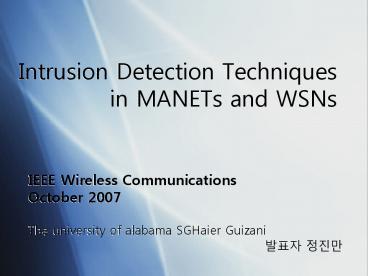Intrusion Detection Techniques in MANETs and WSNs - PowerPoint PPT Presentation
1 / 20
Title:
Intrusion Detection Techniques in MANETs and WSNs
Description:
Intrusion Detection Techniques in MANETs and WSNs. IEEE Wireless ... Deployed in adverse or hostile environment. Ad-hoc, wire ... B and B forwards ... – PowerPoint PPT presentation
Number of Views:469
Avg rating:3.0/5.0
Title: Intrusion Detection Techniques in MANETs and WSNs
1
Intrusion Detection Techniques in MANETs and WSNs
- IEEE Wireless Communications
- October 2007
- The university of alabama SGHaier Guizani
- ??? ???
2
MANET and WSN Constraint
- Resource constraint
- Memory
- Battery
- CPU power
- Network constraint
- Deployed in adverse or hostile environment
- Ad-hoc, wire-less, Radio jamming
- (Do not rely on a pre-existing network
infrastructure) - Management constraint
- Usually no centralized authority
- No base stations (Each nodes acts as router)
3
IDS-Intrusion Detect System
- IDS - dynamically monitors the system to detect
compromise of confidentiality, availability and
integrity. - Two common types -
- misuse based - stores database of known attacks
- anomaly based - creates normal profile of system
states or user behaviors (difficult to built,
mobility challenges) - Specification based
- detect attacks as deviations from a nomal profile
- manually developed specs, time-consuming
4
IDS - attacks
- Routing logic compromise
- Blackhole(man in the middle step)
- routing update storm
- Traffic Distortion
- Packet dropping, corruption, flooding
- Identify Impersonation
5
Existing Research-1Huang et al
- Cross-Feature Analysis-learning based method to
capture correlation patterns. - L features - f1,f2,,fL
- fi - feature characterizing topology or route
activities - Solve classification problem -
- Create Set Ci f1,,fi-1,fi1,,fL -gtfi,
- Ci - very likely to predict in normal
circumstances, very unlikely during attack
6
Existing Research-1Huang et al
- An Illustrative Example
7
Existing Research-1Huang et al
- (Ex) Reachable, Delivered, Cached True, False,
False - (1) Average Match Count (AMC)
- gt (111)/3 1
- (2) Average Probability (AP)
- gt (0.51.01.0)/3 0.83
8
Existing Research-2 Marti et al
- Each node verifies that his data was forwarded
correctly. (Protocal based on DSR - dynamic
source routing) - Watchdog and Pathrater to identify and respond to
routing misbehaviors. - Rate routes and use more reliable ones.
9
Watchdog
- A packet is traveling from S to D
- The packet reaches B and B forwards it to C
- A can overhear this transmission and verify that
B has attempted to pass the packet to C
10
Pathrater
- Each node maintains a rating for every other node
it knows about in the network - Newly known nodes starting from 0.5
- Increase 0.01 if the node is used by active route
- Decrease 0.05 if detects a link break, and the
node becomes unreachable during packet relay - Assign 100 to misbehaving nodes
- Calculates the path metric by averaging the node
ratings in the path, and choose the path with
highest metric
11
Existing Research-3Tseng et al
- Based on AODV - specification based IDS
- Detects run time violations with Network Monitors
- FSM - specify behaviors of AODV
- Maintain RREP and RREQ messages
12
Example AODV Scenario with Network Monitors (NM,
N1 and N2)
Packets Seen by NM in Each Time Slot
Session Tree built by NM in Each Time Slot ( -
RREQ only RREQ and RREP)
13
Examples of Detecting Attacks
Existing Research-3Tseng et al
- Man in the middle attack
- And the sender of m1 and m2, M, is not the owner
of SN (A or D) - SN forged alarm is triggered and the attack is
detected - m1 and m2 is not able to fit in the session tree
that active forged alarms will be triggered.
14
Existing Research-4 Huang and Lee
- More accurate, More information
- with Collaboration with neighbors
- Cluster based detection scheme
- FSM - Initial, Clique, Done, Lost
- Specification-based approach
- Ad-hoc On-demand Distance Vector (AODV)
algorithm - Resource constraint problems faced by a MANET are
addressed when these protocols are designed.
15
Cluster-based Intrusion Detection
16
Cluster-based Intrusion Detection
- Finite State Machine of the cluster formation
protocols
INITIAL
LOST
Cluster Recovery protocol
Clique Computation protocol
Cluster Valid Assertion protocol
Repair
Re-election timeout
CLIQUE
DONE
Cluster head Computation protocol
17
Existing Research-5 Sun et al
- Use Markov Chains to characterize feature
- Motivated by ZBIDS (zone based) - locally
generated alerts inside the zone - Gateway Nodes - broadcast alerts within the zone
18
Future Research Directions
- Distributed and Collaboration Model
- (Ask the surrounding nodes to confirm)
19
Future Research Directions
- Deployment Knowledge Understanding of deployed
applications and related attacks - the appropriate audit data sources
consideration to use link change rate as an
indication of mobility - Probability distribution
- Light weight solution for estimation
20
The End

